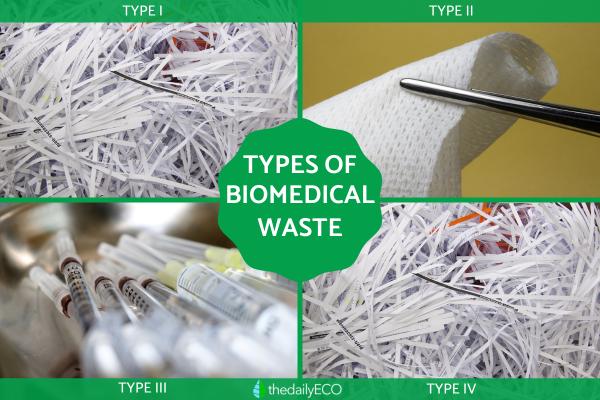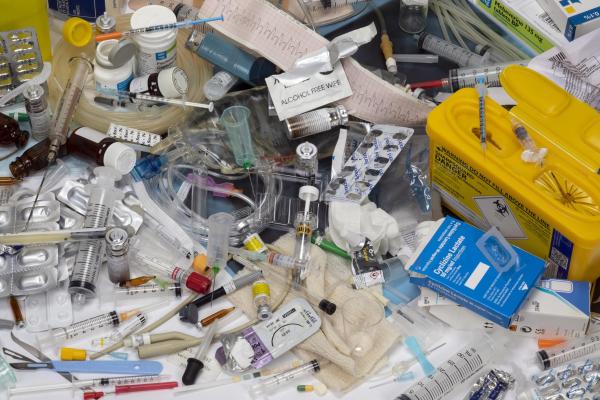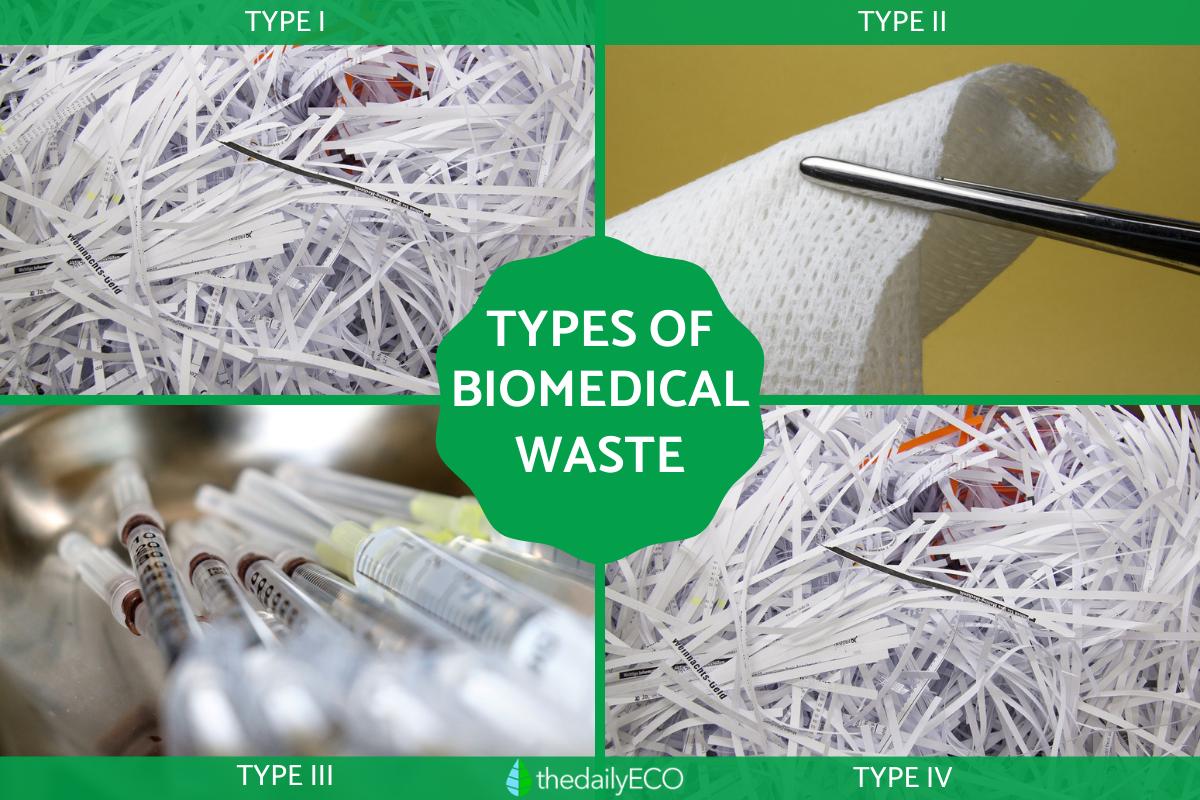Types of Biomedical Waste - Management and Disposal


Biomedical waste is the waste produced in medical institutions which is potentially biologically hazardous. This could be due to pathogens which are contained within them, as well as the type of waste which can cause pollution in the environment. While every industry produces different types of waste, few are as vital as biomedical waste. For this reason, we have to weigh up the benefits and disadvantages of disposing of biomedical waste. On one hand, it is often highly toxic and presents the threat of contagion. On the other, it is a result of necessary medical procedures which save lives.
At thedailyECO, we better understand how medical institutions pose an environmental threat by looking at the different types of biomedical waste. We also see how this threat is best mitigated by the types of biomedical waste management and disposal.
What is biomedical waste?
Biomedical waste is also known as simply medical waste, clinical waste or sometimes sanitary waste, although the latter also includes personal sanitation products not used in the medical industries. Any waste substance which is produced during medical processes for both humans and animals is considered biomedical waste. These include waste from hospitals, surgeries, clinics, sanatoriums, health centers, veterinary clinics and medical research laboratories.
Any waste which is derived from medical processes can be considered biomedical waste, but it is particularly associated with material which has potential pathogens or infectious elements. For example, the blood from an infected wound can contain bacteria which poses a risk to the environment and those within it. However, even unused medical equipment which requires disposal is considered biomedical waste.
Since there are so many different types of medical procedures and processes, the types of biomedical waste are incredibly varied. So too are the methods of waste management and disposal which are required to get rid of them in a way which minimizes harm to humans, animals and the environment.
The risks of biomedical waste
One of the key risks biomedical was waste poses to human health is due to the possible contagion of infectious diseases. An important detail is that this waste fundamentally represents a safety and hygiene problem for those who work in health centers. The risk of infection for the community is minor and is practically limited to certain diseases that are not endemic.
For example, sharp and sharp sanitary waste can be a potential hazard if not disposed of properly. When biomedical waste containing liquids is deposited in the wrong container, there is a risk of spillage into the environment. This occurs when the characteristics of said container are not conducive to containing liquids.
While biomedical waste in itself provides a pollution, contagion and public health risk, improper management and disposal are the key concerns. When clinical waste is not treated properly, it can pose severe environmental risks. These can include the release of toxic gases from improper incineration, the release of pollutants into public water systems and even spreading pathogens to patients within a medical center[1].
Many countries have different methods of biomedical waste management and disposal, but they all fall under similar categories. Some are destroyed, others treated and others disposed of in biomedical landfill. There are two main categories, on-site and off-site:
- On-site biomedical waste disposal: the biomedical waste is destroyed or processed in the medical center where it is created.
- Off-site biomedical waste disposal: the biomedical waste is taken to another location for treatment and destruction.
The management of biomedical waste can differ according to country, especially in terms of regulations and legislation. Since so much waste is accrued, some facilities may manage biomedical waste improperly to try to save money. We look at the types of biomedical waste and their management in the sections below.

Types of biomedical waste
Biomedical waste must be separated at source to facilitate its subsequent treatment. This is regardless if it is for on- or off-site disposal. However, there are also different system for categorizing biomedical waste. We begin with the standard Environmental Protection Agency (EPA) biomedical waste types:
Type I - General biomedical waste
This is waste material that is inert or is not biomedically hazardous due to their composition. They do not have special requirements in their waste management and disposal. This group includes material such as paper and cardboard from offices and offices, canteens, gardening and waste from non-infectious patients.
Type II - Infectious medical waste
This includes any material which can pass on infectious pathogens to humans or animals. Within this category we can include human tissue such as bodily organs, blood or other bodily fluids. Prevention methods for handling, collection and transport are required, both on- and off-site. Materials such as bandages, plasters, surgical instruments and others can be included since they come in contact with bodily fluids. They can also include cultures, vials and other laboratory waste which contains infectious pathogens.
Type III - Hazardous biomedical waste
Some waste does not necessarily contain infectious materials, but may be dangerous because it presents other types of hazards. A common example is a type of biomedical waste referred to as ‘sharps’. Perhaps the most common type of sharp is hypodermic needles, but it also includes glassware, sharp surgical instruments, intubation equipment and other materials. Some chemical waste may also be included in this type of hazardous biomedical waste.
Type IV - Radioactive biomedical waste
This is one of the most important from an environmental impact point of view. Radioactive waste is created in laboratories, hospitals and other medical centers thanks to cancer therapies, research, x-rays and other sources. Since these radioactive elements can cause radioactive pollution, they need to be very carefully managed and disposed of. This includes handling by workers and protecting patients, but also once they are sent out to the larger environment.
Types of biomedical waste according to the World Health Organization (WHO)
Another way of grouping the different types of biomedical waste is by the WHO. They have some more specific types according to the equipment and materials which are used and produced in a medical setting. They describe the following as types of healt-care waste:
- Infectious waste: this includes waste contaminated with blood and bodily fluids which can come from infected patients, but which is present on other material such as blood cultures, vials of infectious agents, bandages, etc.
- Pathological waste: organic material such as tissue, organs, bodily fluids or even body parts from humans or animals.
- Sharps: lancets, needles, syringes, scalpels, blades and others.
- Chemical waste: can include solvents, disinfectants, sterilizing agents for surgical equipment and even mercury in thermometers.
- Pharmaceutical waste: mainly consists of drugs, vaccines and other medications which have expired, are contaminated or are otherwise unusable.
- Cytotoxic waste: can include carcinogens from chemotherapy drugs, but generally includes mutagenic, teratogenic or carcinogenic substances which are highly toxic.
- Radioactive waste: these are products used in diagnostics or therapeutic process which contain radionuclides.
- Non-hazardous or general waste: this is general waste used in offices, canteens and other departments which does not poses a specific biomedical harm.
Managing and disposing of biomedical waste is important in protecting humans, animals and ecosystems. Learn more with what is biosecurity with examples?

Types of biomedical waste management and disposal
As we have already stated, the management and disposal of biomedical waste is imperative for protecting people, the environment and ecosystems in general. Although different countries and jurisdictions have their own biomedical waste management regulations, the general forms of management and disposal use the following process:
- Classification at source: for a correct separation of sanitary waste, it must be classified respecting the established classification.
- Collection: for optimal collection, certain basic rules must be taken into account to minimize risk.
- Storage: storage areas must be delimited and marked and located at points close to the places of production. This is important to avoid any unnecessary transfers which can increase contamination risk. Warehouses must be ventilated and subsequently disinfected.
- Transport: it is recommended that the sanitary waste collected from the center be transported to the sanitary waste warehouse within a maximum period of 12 hours. Appropriate bags should be used so that they do not break at the time of transfer. Those workers in charge of these tasks must comply with certain safety regulations to avoid accidents.
- Waste treatment and elimination: the treatment and elimination of sanitary waste from groups III and VI must meet certain criteria of safety, asepsis and health to guarantee the elimination of pathogens and the protection of the environment. Waste from groups I and II are considered municipal waste and the corresponding municipal entity will be the one that will ensure their correct management.
This last process uses the following types of biomedical waste disposal to get rid of the end product:
- Incineration: this involves the burning of the material so that pathogens are killed and the size of the waste is reduced. However, this is not always suitable since the fumes it produces and the material being processed can increase their environmental impact when incinerated.
- Autoclaving: this is the sterilization of biomedical waste using steam for a certain amount of time to kill pathogens and other microorganisms. Not all biomedical waste can be processed in this way, but the majority can. It is also cheaper than incineration.
- Microwaving: using the sterilizing power of microwaves to kill microorganisms before it is sent to landfill. The materials are first mixed with water to allow them to be heated. This can be a good alternative to autoclaving and incineration as it is considered more ecological.
- Chemical disinfection: the use of chemicals to kill pathogens and microorganisms such as bacteria is common in both the domestic and industrial environments. It is also effective for biomedical waste. It is commonly used for liquid biomedical waste since the chemical reaction can make the substance inert. It can then be discarded more safely.
Learn how waste can affect the environment with our guide to types of environmental degradation.
If you want to read similar articles to Types of Biomedical Waste - Management and Disposal, we recommend you visit our Recycling and waste management category.
1. Singh, Z., Bhalwar, R., Jayaram, J., & Tilak, V. W. (2001). AN INTRODUCTION TO ESSENTIALS OF BIO-MEDICAL WASTE MANAGEMENT. Medical journal, Armed Forces India, 57(2), 144–147. https://doi.org/10.1016/S0377-1237(01)80136-2
- EPA. (2022). Medical Waste. Retrieved from:
https://www.epa.gov/rcra/medical-waste - WHO. (2018). Health-care waste. Retrieved from:
https://www.who.int/news-room/fact-sheets/detail/health-care-waste







